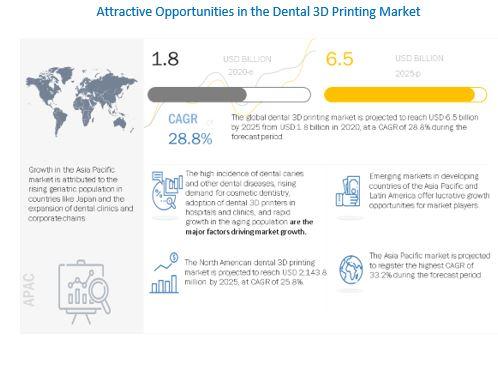
The dental 3D printing medical devices market is primarily driven by factors such as the high incidence of dental caries and other dental diseases, rising demand for cosmetic dentistry, the growing adoption of dental 3D printers in hospitals and clinics, and rapid growth in the geriatric population.
The dental 3D printing market was initially negatively impacted by the COVID-19 pandemic, as most dental offices, clinics, and laboratories were closed in many parts of the world due to lockdowns and quarantine restrictions in early 2020. This resulted in all non-essential dental procedures being deferred; the volume of outpatient cases reduced considerably in this period. However, recovery can be seen in most regions, especially North America and Europe, as dental services regain normalcy.
In an optimistic scenario, the need for smoother clinical workflows, faster turnaround times, and fewer dental appointments could boost market growth. Dentists may be more likely to invest in technologies like CAD/CAM and dental 3D printing to reduce the time taken to deliver dental appliances and treatment, and patients may be more likely to opt for these solutions for the same reason.
For More Info @ https://tinyurl.com/44ah2kx7
According to the American College of Prosthodontists, more than 36 million Americans are completely edentulous, and around 120 million Americans are missing at least one tooth. As dental implants, dental prosthetics, and other dental products manufactured by dental 3D printers find high use in the restoration of the dental structure, the high incidence of target diseases will play a key role in the growth of the dental 3D printing market during the forecast period.
One of the prominent barriers to the adoption of additive manufacturing or 3D printing is the lack of a skilled workforce. There is a very limited resource pool available for staff that is well-versed with 3D printing processes, which is further worsened by the rapid pace of evolution of the dental 3D printing market in terms of technology and materials.

There is a dearth of training programs available for additive manufacturing and a wide gap between academia and practical applications in the industry that is difficult to bridge. The lack of a well-qualified workforce would restrain the overall adoption of dental 3D printing.
The cost of a high-resolution 3D printer is around USD 40,000 to USD 100,000. This also makes it difficult for laboratories dependent on federal funding (for whom securing funds in itself is a time-consuming process) to install and use such equipment. Due to this financial aspect, many smaller dental clinics may choose to outsource production to service bureaus or laboratories.
The fused deposition modeling segment is projected to register the highest growth rate in the dental 3D printing market, by technology during the forecast period. In dentistry, FDM is a widely applied technology due to the availability of a wide range of biocompatible, strong, and sterilizable thermoplastics.
























